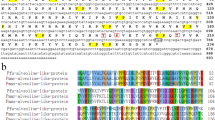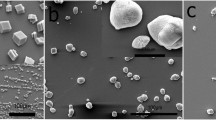Abstract
In the animal kingdom, DING proteins were only found in Chordata and Aschelminthes. At present study, a potential DING protein, matrix protein N38, was isolated and purified from the shell of Pinctada fucata. Tandem mass spectrometry analysis revealed that 14 peptide segments matched between N38 and human phosphate-binding protein (HPBP). HPBP belongs to the DING protein family and has a “DINGGG-” sequence, which is considered a “signature” of HPBP. In this study, the mass spectrometry analysis results showed that N38 had a “DIDGGG-” sequence; this structure is a mutation from the “DINGGG-” structure, which is a distinctive feature of the DING protein family. The role of N38 during calcium carbonate formation was explored through the in vitro crystallization experiment. The results of scanning electron microscopy and Raman spectrum analysis indicated that N38 induced vaterite formation. These findings revealed that N38 might regulate and participate in the precise control of the crystal growth of the shell, providing new clues for biomineralization mechanisms in P. fucata and DING protein family studies. In addition, this study helped extend the research of DING protein to the Mollusca world.







Similar content being viewed by others
References
Addadi L, Moradian J, Shay E, Maroudas NG, Weiner S (1987) A chemical model for the cooperation of sulfates and carboxylates in calcite crystal nucleation: relevance to biomineralization. Proc Natl Acad Sci USA 84:2732–2736
Ahn S, Moniot S, Elias M, Chabriere E, Kim D, Scott K (2007) Structure-function relationships in a bacterial DING protein. FEBS Lett 581:3455–3460
Aizenberg J, Lambert G, Weiner S, Addadi L (2002) Factors involved in the formation of amorphous and crystalline calcium carbonate: a study of an ascidian skeleton. J Am Chem Soc 124:32–39
Berna A, Bernier F, Chabrière E, Perera T, Scott K (2008) DING proteins; novel members of a prokaryotic phosphate-binding protein superfamily which extends into the eukaryotic kingdom. Int J Biochem Cell Biol 40:170–175
Berna A, Bernier F, Chabrière E, Elias M, Scott K, Suh A (2009) For whom the bell tolls? DING proteins in health and disease. Cell Mol Life Sci 66:2205–2218
Berna A, Bernier F, Scott K, Stuhlmüller B (2002) Ring up the curtain on DING proteins. FEBS Lett 524:6–10
Berna A, Scott K, Chabrière E, Bernier F (2010) The DING family of proteins: ubiquitous in eukaryotes, but where are the genes? BioEssays 31:570–580
Boskey AL (1996) Matrix proteins and mineralization: an overview. Connect Tissue Res 35:357–363
Checa AG, Macías-Sánchez E, Ramírez-Rico J (2016) Biological strategy for the fabrication of highly ordered aragonite helices: the microstructure of the cavolinioidean gastropods. Sci Rep 6:25989
Coleman JE (1992) Structure and mechanism of alkaline phosphatase. Ann Rev Biophys Biomol Struct 21:441–483
Darbinian N, Czernik M, Darbinyan A, Elias M, Chabriere E, Bonasu S, Khalili K, Amini S (2009) Evidence for phosphatase activity of p27SJ and its impact on the cell cycle. J Cell Biochem 107:400–407
Diemer H, Elias M, Renault F, Rochu D, Chabriere E (2010) Tandem use of X-ray crystallography and mass spectrometry to obtain ab initio the complete and exact amino acids sequence of HPBP, a human 38-kDa apolipoprotein. Proteins Struct Funct Bioinform 71:1708–1720
Elliott JC (1990) Biomineralization: chemical and biochemical perspectives. FEBS Lett 265:149–149
Fabio N, Eyal S, Eugenia K, Marthe R et al (2008) Forming nacreous layer of the shells of the bivalves Atrina rigida and Pinctada margaritifera: an environmental- and cryo-scanning electron microscopy study. J Struct Biol 162:290–300
Falini G, Albeck S, Weiner S, Addadi L (1996) Control of aragonite or calcite polymorphism by mollusk shell macromolecules. Science 271:67–69
Faraone-Mennella MR, Gambacorta A, Nicolaus B, Farina B (1998) Purification and biochemical characterization of a poly(ADP-ribose) polymerase-like enzyme from the thermophilic archaeon Sulfolobus solfataricus. Biochem J 335:441–447
George A, Sabsay B, Simonian P, Veis A (1993) Characterization of a novel dentin matrix acidic phosphoprotein. Implications for induction of biomineralization. J Biol Chem 268:12624–12630
Heinemann F, Treccani L, Fritz M (2006) Abalone nacre insoluble matrix induces growth of flat and oriented aragonite crystals. Biochem Biophys Res Commun 344:45–49
Hendriks ML, Lambalk CB, Helder MN, Koning JD (2011) Purification of a candidate gonadotrophin surge-inhibiting/attenuating factor (GnSIF/AF) showing MAPK as a possible target. Mol Reprod Dev 78:292–304
Hunter GK (1996) Interfacial aspects of biomineralization. Curr Opin Solid State Mater Sci 1:430–435
Ji HM, Yang W, Chen DL, Li XW (2020) Natural arrangement of fiber-like aragonites and its impact on mechanical behavior of mollusk shells: a review. J Mech Behav Biomed Mater 110:103940
Kadurugamuwa JL, Beveridge TJ (1995) Virulence factors are released from Pseudomonas aeruginosa in association with membrane vesicles. J Bacteriol 177:3998–4008
Kumar V, Yu S, Farell G, Toback FG, Lieske JC (2004) Renal epithelial cells constitutively produce a protein that blocks adhesion of crystals to their surface. Am J Physiol Renal Physiol 287:F373–F383
Lesner A, Shilpi R, Ivanova A, Gawinowicz MA, Lesniak J, Nikolov D, Simm M (2009) Identification of X-DING-CD4, a new member of human DING protein family that is secreted by HIV-1 resistant CD4(+) T cells and has anti-viral activity. Biochem Biophys Res Commun 389:284–289
Liu X, Dong S, Jin C, Bai Z, Li J (2015) Silkmapin of Hyriopsis cumingii, a novel silk-like shell matrix protein involved in nacre formation. Gene 555:217–222
Lowenstam H (1981) Minerals formed by organisms. Science 211:1126–1131
Mann S (1988) Molecular recognition in biomineralization. Nature 332:119–124
Marin F, Luquet G (2004) Molluscan shell proteins. Comptes Rendus - Palevol 3:469–492
Megha S, Alexander Z, Alverdy JC, Ken S, Olga Z (2014) Localization of DING proteins on PstS-containing outer-surface appendages of Pseudomonas aeruginosa. FEMS Microbiol Lett 352:54–61
Mehta A, Lu X, Block T, Willis A, Dwek R, Tennant B, Blumberg B (2001) Synovial stimulatory protein fragments copurify with woodchuck hepatitis virus: implications for the etiology of arthritis in chronic hepatitis B virus infection. Arthritis Rheum 44:486–487
Mehta M, Chowdhury M (1999) A mannose-binding glycoprotein found in the 4 day post coital rat uterus is involved in pregnancy. Mol Cell Biochem 195:65
Morales R, Berna A, Carpentier P, Contreras-Martel C, Renault F, Nicodeme M, Chesne-Seck ML, Bernier F, Dupuy J, Schaeffer C (2006) Serendipitous discovery and X-ray structure of a human phosphate binding apolipoprotein. Structure 14:601–609
Natoli A, Wiens M, Schröder H-C, Stifanic M, Batel R, Soldati AL, Jacob DE, Müller WEG (2010) Bio-vaterite formation by glycoproteins from freshwater pearls. Micron 41:359–366
Pantazaki AA, Tsolkas GP, Kyriakidis DA (2008) A DING phosphatase in Thermus thermophilus. Amino Acids 34:437–448
Porzio E, Maio AD, Ricciardi T, Mistretta C, Manco G, Faraone-Mennella MR (2018) Comparison of the DING protein from the archaeon Sulfolobus solfataricus with human phosphate-binding protein and Pseudomonas fluorescence DING counterparts. Extremophiles 22:177–188
Robertson D, Mitchell GP, Gilroy JS, Gerrish C, Bolwell GP, Slabas AR (1997) Differential extraction and protein sequencing reveals major differences in patterns of primary cell wall proteins from plants. J Biol Chem 272:15841–15848
Rochu D, Renault F, Cléry-Barraud C, Habrière EC, Masson P (2007) Stability of highly purified human paraoxonase (PON1): association with human phosphate binding protein (HPBP) is essential for preserving its active conformation(s). BBA - Proteins Proteom 1774:874–883
Sachdeva R, Darbinian N, Khalili K, Amini S, Gonzalez D, Djeghader A, Chabriére E, Suh A, Scott K, Simm M (2013) DING proteins from phylogenetically different species share high degrees of sequence and structure homology and block transcription of HIV-1 LTR promoter. Plos One 8:e69623
Selvaraj V (2020) Alkaline phosphatase: structure, expression and its function in bone mineralization. Gene 754:144855
Shih D, Gu L, Xia YR, Navab M, Li WF, Hama S, Castellani LW, Furlong CE, Costa LG, Fogelman AM (1998) Mice lacking serum paraoxonase are susceptible to organophosphate toxicity and atherosclerosis. Nature 394:284–287
Siller AF, Whyte MP (2017) Alkaline phosphatase: discovery and naming of our favorite enzyme. J Bone Miner Res Off J Am Soc Bone Miner Res 33:362–364
Snell TW, Kubanek J, Carter W, Payne AB, Kim J, Hicks MK, Stelzer CP (2006) A protein signal triggers sexual reproduction in Brachionus plicatilis (Rotifera). Mar Biol 149:763–773
Suh A, Douce VL, Rohr O, Schwartz C, Scott K (2013) Pseudomonas DING proteins as human transcriptional regulators and HIV-1 antagonists. Virol J 10:234–234
Todorov PT, Wyke SM, Tisdale MJ (2007) Identification and characterization of a membrane receptor for proteolysis-inducing factor on skeletal muscle. Can Res 67:11419–11427
Weebadda W, Hoover GJ, Hunter DB, Hayes MA (2001) Avian air sac and plasma proteins that bind surface polysaccharides of Escherichia coli O2. Comp Biochem Physiol B Biochem Mol Biol 130:299–312
Xie LP, Wu YT, Dai YP, Li Q, Zhang RQ (2007) A novel glycosylphosphatidylinositol-anchored alkaline phosphatase dwells in the hepatic duct of the pearl oyster, Pinctada fucata. Mar Biotechnol 9:613–623
Xue YA, Dong YA, Yi YA, Sl A, Zh A, Yj A, Gz A, Lx A, Rzab C (2020) A novel matrix protein PfX regulates shell ultrastructure by binding to specific calcium carbonate crystal faces. Int J Biol Macromol 156:302–313
Yan Y, Yang D, Yang X, Liu C, Xie J, Zheng G, Xie L, Zhang R (2017) A novel matrix protein, PfY2, functions as a crucial macromolecule during shell formation. Sci Rep 7:6021
Yang D, Yan Y, Yang X, Liu J, Zheng G, Xie L, Zhang R (2019) A basic protein, N25, from a mollusk modifies calcium carbonate morphology and shell biomineralization. J Biol Chem 294:8371–8383
Zaborina O, Holbrook C, Chen Y, Long J, Zaborin A, Morozova I, Fernandez H, Wang Y, Turner JR, Alverdy JC (2008) Structure–function aspects of PstS in multi-drug–resistant Pseudomonas aeruginosa. Plos Pathogens 4:e43
Funding
This study was financially supported by the National Natural Science Foundation of China (32072975) and the National Key R &D Program of China (2018YFC0310600). We thank International Science Editing (http://www.internationalscienceediting.com) for editing this manuscript.
Author information
Authors and Affiliations
Corresponding authors
Ethics declarations
Conflict of Interest
The authors declare no competing interests.
Additional information
Publisher's Note
Springer Nature remains neutral with regard to jurisdictional claims in published maps and institutional affiliations.
Xin Zhang and Zehui Yin contributed equally to this work.
Rights and permissions
About this article
Cite this article
Zhang, X., Yin, Z., Ma, Z. et al. Shell Matrix Protein N38 of Pinctada fucata, Inducing Vaterite Formation, Extends the DING Protein to the Mollusca World. Mar Biotechnol 24, 531–541 (2022). https://doi.org/10.1007/s10126-022-10116-0
Received:
Accepted:
Published:
Issue Date:
DOI: https://doi.org/10.1007/s10126-022-10116-0




